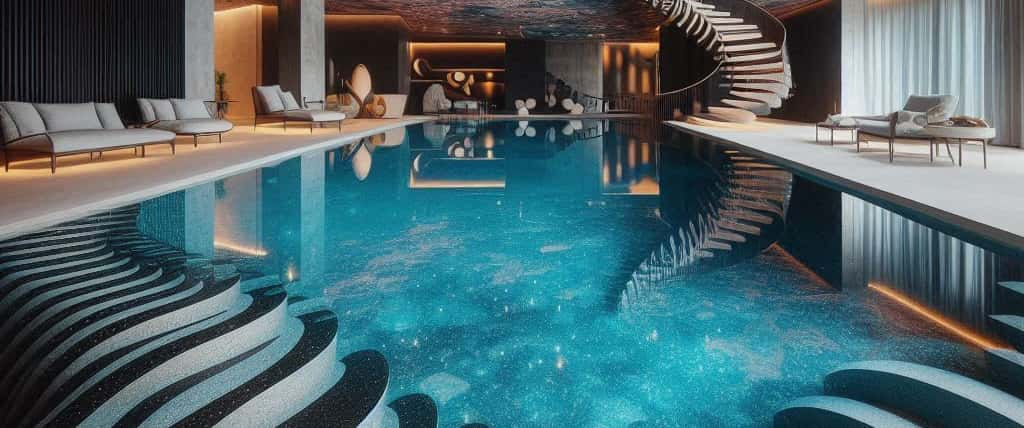Swimming pools and features add to a property something beautiful, tranquil, and an added sense of luxury; yet they are not fun to keep if the pool owner did not choose wisely. In that regard, epoxy offers a good medium for maintaining swimming pools and water features. The following article has explained how it works with the intention of perfecting application for water features and other uses.
What Is Epoxy?
Epoxy is a kind of resin resulting from a hardener that usually creates a strong, lasting, and waterproof surface when mixed. It is such a versatile material and therefore finds applications in many industries including construction, automotive, and marine. In swimming pool and water feature applications, epoxy has great resistance to water, chemicals, and mechanical wear.
Why Use Epoxy for Swimming Pools?
To protect your swimming pool or water feature effectively and properly, it is essential to choose a material that can withstand harsh conditions. Here are some reasons to use epoxy:
Waterproofing:
Epoxy creates a seamless, glossy, waterproof layer that prevents leaks and water seepage. This ensures the structure stays intact for years.
Durability:
Durability is such reason that convince people to use epoxy. Epoxy is resistant to continuous water, UV rays, and chemical exposure. It will not crack or peel, making it suitable for long-term use.
Aesthetic Appeal:
Epoxy comes in a variety of colors and finishes which enabling one to innovatively develop exceptionally attractive and brilliant designs. You can opt for glossy, matte, or textured finishes to suit your taste.
Easy Maintenance:
Epoxy surfaces require very little maintenance; they would just need to be cleaned from time to time. Dirt and algae just wipe off effortlessly, keeping your pool always in perfect and attractive condition.
Resistance to Chemical Attack:
Pool chemicals can’t damage an epoxy coating; the surface won’t break down and get into an unsafe condition.
Where to Apply Epoxy
Epoxy can be used on most areas around and under the water surface of pools and water features, including:
Pool floors and walls: The smooth, water-impermeable membrane prevents leakage.
Pool Decks:
For adding traction and preventing slipping while aesthetically enhancing the appearance.
Fountains and Waterfalls:
For a waterproof application that provides enduring beauty.
Koi Ponds and Water Gardens:
For creating non-toxic, safe environments for the aquatic organisms. That’s really an amazing idea.
How to Apply Epoxy to Pools and Water Features
The application process for epoxy does require prep and execution with care in mind. Here are the general steps for a successful procedure:
1.Prepare the Surface
Clean the surface well for proper bonding:
Clean off dirt and algae by using a pressure washer or scrub brush.
Fill in any cracks or holes with an appropriate filler.
You may lightly sand the surface.
2.Mix the Epoxy
To activate epoxy, combine the resin and hardener according to the manufacturer’s instructions:
Take a clean container and a stirring stick.
Mix well to get a uniform consistency.
Stir gently but at a constant pace to avoid bubbles.
3.Apply the Epoxy
Smoothening and an even coat can be achieved by following these tips:
Apply by roller or brush.
Start in one corner and work your way across.
Apply in thin layers to avoid uneven drying.
Let the first layer dry completely before applying a second coat.
4.Let It Cure
Epoxy does take some time to cure and set:
Follow the recommended curing time by the manufacturer, ranging from 24 to 72 hours.
Ensure that no water or debris touches this surface during this period.
Examples of Epoxy Use
Here are some examples to demonstrate how epoxy can transform pools and other water features:
1. Residential Pool Makeover
Imagine a homeowner having a concrete pool in front of his home that has started to look dull and worn. To restore its beauty, they decide to use epoxy. After cleaning the pool, they apply a bright blue epoxy coating. The final result is a vibrant, glossy finish that looks brand new.
2. Fountain Restoration
A crack found in a public park’s fountain; and so, leaks are common. The maintenance team uses epoxy to seal the cracks and coat the surface for some unique and attractive design. It stops not only the leakage but also provides a polished, elegant view to the fountain.
3. Decorative Water Garden
A homeowner wants to create a stunning water garden with colorful stones and aquatic plants.
They use clear epoxy to coat the base of the garden. This ensures waterproofing and enhances the colors of the stones, creating a beautiful and functional feature.
Tips for Success
To get the most out of epoxy, follow these tips:
Choose High-Quality Products:
To make sure it will last, select epoxy products designed for pools and water features specifically.
Work in Ideal Conditions:
Apply epoxy in dry weather and at recommended temperatures to ensure proper curing.
Follow Manufacturer’s Instructions:
Every epoxy product is different, so always read and follow the instructions.
Hire Professionals:
If you’re unsure about the application process, hire professionals to get the job done.
Common Questions About Epoxy for Pools
- Is epoxy safe for fish and plants?
Yes, epoxy is non-toxic when cured Epoxy is safe for making koi ponds and water gardens.
- How long does epoxy last on pools?
Epoxy, when applied, maintained properly as well, can last 7 to 10 years or more.
- Can you reapply epoxy over an old coat?
Yes, you can, but that’s not recommended.
That need proper cleaning and other necessary maintainance.
Conclusion
Using epoxy for swimming pools and water features is definitely a wise choice. It’s durable, waterproof, and aesthetically pleasing. For best results, follow the steps for application to the letter and seek professional help when needed. With epoxy, one can make a pool or water feature truly beautiful and very durable.


